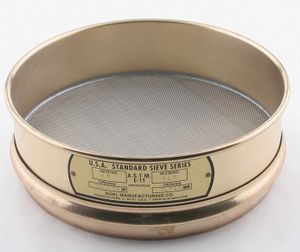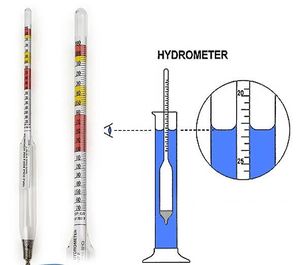Soil Particle Size Analysis Methods
Soil Particle Size Analysis Methods

There are three basic classifications of soil particle size. They include clay, silt and sand, from smallest to largest, respectively. There are several different methods to determining how much clay, silt and sand is in a sample of soil, two include sieving, and another which uses a hydrometer. There is another method used in determining the amount of organic mater in soil, to do this one might use the Loss on Ignition test, however the purpose of this article will be to focus on clay, silt and sand only.
Sieving
To begin, the soil sample needs to be dried to a constant weight, for 24 hrs at 120˚F this will eliminate all the moisture held in the soil. Once the soil is dried to constant weight, the sieving can begin. The sieves come with different size screens and they should be chosen according to the particles that are to be isolated.
There should be one sieve on top with larger holes to accommodate for gravel that is in the soil. Gravel includes any particle larger than 2mm and will be considered as "sand". [1]

Course sand particles range from 1.0 - 2.0 mm while very fine sand particles range from 0.05 - 0.10mm.[1] Choosing two or more sieves within that range might be helpful to account for larger or smaller sand particles; for instance, include a sieve at 2.0mm and one at 0.05mm. Silt particles ranges from 0.05mm - 0.002 mm [1], therefore a sieve with a corresponding screen hole size of 0.002 mm should suffice.
Lastly, clay particles are anything smaller than 0.002mm. [1] At the bottom of the stack of sieves should be placed a bottom container with a solid bottom to collect the clay particle that will sift past the 0.002mm sieve.
Once the sieves are set up, the soil sample that has been dried to a constant weight will be sifted through the sieves using a sieve shaker. After about 15-20 min of shaking the soil should be separated into gravel, sand, silt and clay. The proportions can then be calculated to determine how much of each particle is one soil sample. For instance, 26g sand/50g total soil = 52% sand.
Soil sieving is a purely mechanical process of determining soil particle size in a sample of soil. [2] A better method to accurately separating clay particles from the soil would be to use a hydrometer.
Hydrometer
Because clay particles are made up of either three or four charged ions, they tend to cling to one another [3], this being called flocculation[4]. This can sometimes pose a problem when trying to accurately determine the proportion of clay particles in a sample of soil. Measuring soil samples using a hydrometer will give an accurate reading of sand silt and clay particles.

To measure using a hydrometer, a solution of water mixed with sodium hexametaphosphate is prepared and poured into a 1000ml graudated cylinder. The soil sample (for example 50g soil) is then poured into the solution and shaken or stirred until evenly distributed. The hydrometer is then placed in the graduated cylinder, and a measurement is read off of it after 40 seconds. The hydrometer is then taken out and the solution of soil, water, and sodium hexmetaphosphate it stirred or shaken again. Another 40 second reading will be taken and then an average of the two readings will be calculated to determine the amount of sand (and gravel) in the sample. The solution, with the hydrometer in it still, will then sit for at least an hour, the reading on the hydrometer will show the amount of clay in the sample, and the remainder of the sample will be silt.
The proportion of clay is able to be determined due to the sodium hexametaphospahte, which acts as a defloccuant, meaning the clay particle ions will now repulse each other instead of clinging to one another. [4,5]
References
1. Whiting, David, et al. Estimating Soil Texture. 2003, Estimating Soil Texture, culter.colorado.edu/~kittel/SoilChar(&RibbonTest)_handout.pdf.
2. “Particle Size Analysis (for Soils/Sediments).” UCL Department of Geography, www.geog.ucl.ac.uk/resources/laboratory/laboratory- methods/particle-size-analysis/particle-size-analysis-for-soils-sediments.
3. “1.8 Clay Mineral Structure.” Fundamentals of Soil Ecology, by David C. Coleman et al., Academic Press, 2018.
4. Tozzi, Nilo. “Deflocculants: A Detailed Overview.” Deflocculants: A Detailed Overview, digitalfire.com/4sight/education/deflocculants_a_detailed_overview_324.html.
5. Andreola, Fernanda, et al. “The Role of Sodium Hexametaphosphate in the Dissolution Process of Kaolinite and Kaolin.” Journal of the European Ceramic Society, Elsevier, 24 Sept. 2003, www.sciencedirect.com/science/article/pii/S0955221903003662.